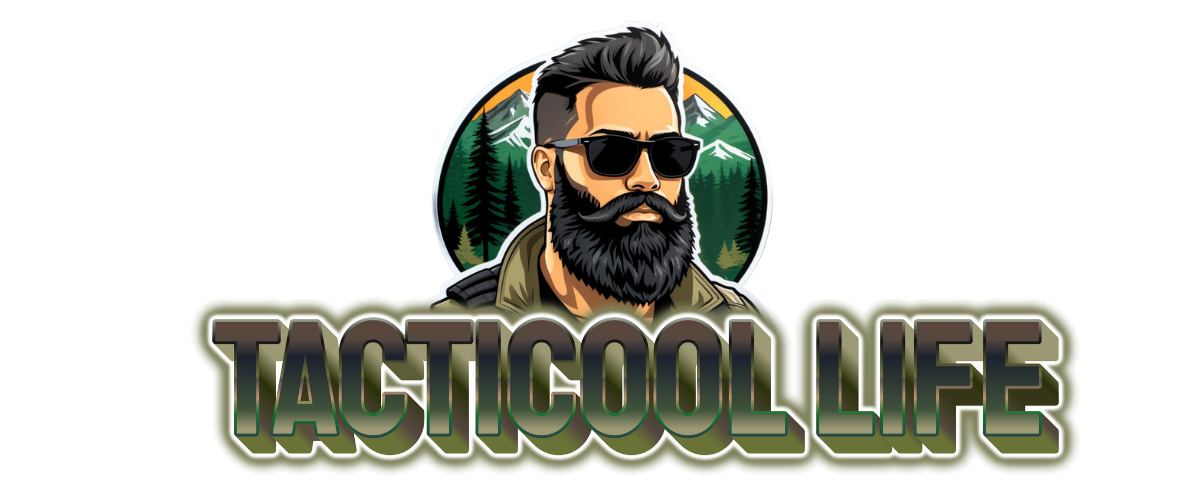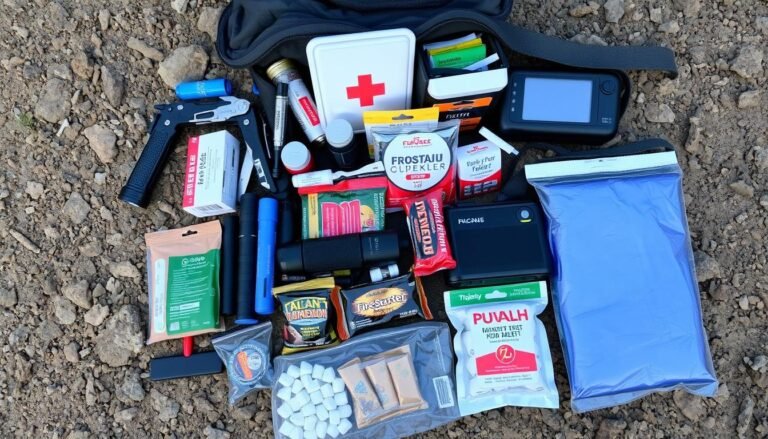There’s a deep connection between humans and water. It speaks to our survival needs and our desire to explore the wilderness. I felt a sense of lightness when I got lost in the woods. But then, I realized my water was running low.
This was when I understood the importance of survival water purification techniques. They are not just skills, but a lifeline in nature’s harshness.
Whether it’s a planned trip or an unexpected challenge, knowing how to purify water in the wild is crucial. The beauty of nature can quickly become dangerous if we’re not ready to treat water. In this guide, we’ll explore wilderness survival water treatment and outdoor water treatment solutions to keep your adventures safe.
When you’re out exploring, remember to stay hydrated. It’s not just about drinking water; it’s about staying alive. My experiences have taught me the value of water purification. It’s as important as your compass and courage.
Hey there! Just a heads-up—some of the links on this site are affiliate links, which means I may earn a small commission if you make a purchase through them. This comes at no additional cost to you. As an Amazon Associate, I earn from qualifying purchases. I only recommend products I genuinely believe in and have used myself. Your support helps keep this site running, so thank you!
Key Takeaways
- Understanding essential water purification methods can be crucial for outdoor survival.
- Water sources in the wild, often seen as pristine, can contain harmful contaminants.
- Purification methods range from modern portable filters to ancient distillation techniques.
- Combining methods, such as boiling and chemical treatment, can increase safety.
- Always be prepared with multiple water treatment options before venturing into the wilderness.
- Safe water consumption is more than a convenience; it’s a necessity for wilderness health.
Understanding the Importance of Water Purification in Survival Situations
When you go into the wilderness, clean drinking water is key. Our bodies need water to work right, especially in tough places. Making sure water is safe is vital to avoid health problems.
The Crucial Role of Clean Drinking Water
Water helps our bodies in many ways, like keeping us cool and removing toxins. But, it must be clean. Bad water can turn a survival trip into a serious danger. So, learning how to find safe water is very important.
Risks Associated with Unpurified Water
Unsafe water can carry harmful germs like viruses and bacteria. These can cause serious illnesses like cholera and dysentery. Every year, millions of people die from these diseases, showing how crucial clean water is.
Timeframe: Surviving without Water
You can only survive about three days without water. This shows how fast you need to find and clean water in survival situations. It’s a race against time to stay safe.
If you’re in a survival situation, knowing how to purify water can save your life. Here are some effective ways to do it:
| Method | Key Benefit | Typical Use | Limitation |
|---|---|---|---|
| Boiling | Kills pathogens | Anywhere with heat source | Requires fuel |
| Chemical Tablets | Portable | Emergency kits | Taste alteration |
| UV Purification | Effective against all pathogens | Clear water required | Battery dependent |
| Ceramic Filters | Removes bacteria, protozoa | Base camps, homes | Not effective on viruses |
| SODIS | Eco-friendly, no cost | Sunny regions | Weather dependent |
In summary, knowing how to purify water is crucial for survival. It keeps you healthy in the outdoors. So, always make sure you have access to clean drinking water.
Identifying Safe Water Sources in the Wilderness
Finding safe water in the wilderness is key to survival. It’s especially important when you’re far from civilization. I’ll show you how to spot safe water sources and the signs to look for.
Surface Water Vs. Groundwater
It’s important to know the difference between surface and groundwater. Surface water includes rivers, streams, and lakes. Groundwater is found in springs and wells. While flowing water is safer, it’s still important to treat it before drinking.
Signs of Potentially Safe Water
Clarity is a good sign, but not always a guarantee. Stay away from water near animal waste or old mining sites. Clean water might lack algae and debris. But, always treat water found in the wild. Let’s look at some common ways to treat water.
| Method | Description | Effectiveness |
|---|---|---|
| Boiling | Boil water for at least 3 minutes to kill bacteria and protozoa. | Highly effective against all microorganisms |
| Chemical Tablets | Use iodine, chlorine, or potassium permanganate to purify water. | Effective against many pathogens, but not all |
| Microfiltration | Use filters to physically remove pathogens from water. | Depending on the filter, can remove up to 99.999% of contaminants |
| Stone Boiling | Heat stones and then place them in water to bring it to a boil. | Alternative method when lacking a container to boil water |
| Distillation | Vaporize water by boiling and then condense the steam back into liquid. | Effective at removing salts and minerals; ideal in salty water sources |
Knowing how to treat water is crucial for wilderness survival. It’s not just a skill; it’s a matter of safety. By using the right methods, you can ensure clean drinking water, keeping your adventure safe and healthy.
Native Water Purification Knowledge
Exploring indigenous water filtration methods gives us valuable insights. These methods are not just for survival. They are deeply connected to the culture of the people who use them. By learning these natural water purification techniques, we can mix old wisdom with new science. This helps us stay strong, especially in the wilderness.
Many traditional groups use sand, charcoal, and plants to filter water. This knowledge is key when we can’t use modern tech. For example, using gravel and sand filters out particles. It also makes boiling or using natural chemicals more effective.
Let’s see how these methods compare today:
| Method | Efficiency | Materials Used | Cultural Relevance |
|---|---|---|---|
| Charcoal Filtration | High | Charcoal, sand, gravel | Common in many indigenous cultures worldwide |
| Sand Filtration | Medium to high | Fine and coarse sand layers | Widely used in ancient Egyptian and Indian civilizations |
| Plant-Based Filtration | Variable | Moringa seeds, Strychnos potatorum | Integral to specific Asian and African communities |
In summary, using natural water purification techniques and indigenous water filtration methods today is very important. This knowledge, passed down for centuries, teaches us about living sustainably. It shows us how to respect nature’s complexity.
How to Purify Water in the Wild
Purifying water in the wilderness is key for survival. There are many effective water purification techniques to ensure safe drinking water. We’ll explore practical ways to do this when you’re far from a tap.
Pre-filtering Techniques Using Natural Materials
Start by pre-filtering water with natural materials like moss or sand. This step removes big particles. It’s a crucial first step in wilderness water treatment techniques. It also helps portable filters last longer by preventing clogs.
Boiling Water: The Most Accessible Purification Method
Boiling for water decontamination is simple and works well. Boil water for at least 10 minutes to kill harmful germs. Remember, water is heavy, so boiling a lot needs a lot of fuel and time.
Chemical Disinfectants: Pros and Cons
Chemicals like iodine or chlorine tablets are also used to purify water. They kill many pathogens and are light, making them easy to carry. But, they might not work as well in cold or cloudy water, needing more time.
| Method | Effectiveness | Usage Notes |
|---|---|---|
| Boiling | High | Needs heat source and time |
| Chemical Tablets | Variable | Depends on temperature and sediment |
| UV Purifiers | High in clear water | Effective for small quantities |
| Charcoal Filters | Moderate | Removes sediment and some pathogens |
It’s important to know about boiling for water decontamination and other methods for wilderness survival. Whether it’s a quick trip or a long stay, treating water sources right can save your life. Each method has its own advantages and disadvantages. Often, mixing methods based on what you have and need is the best way to stay safe.
DIY Water Filtration Systems and Their Effectiveness
In emergency or wilderness situations, knowing diy water filtration methods is key. Making your own filter from common materials gives you a sense of control. It also shows how effective homemade water filtration can be.
Building these filters starts with simple items like sand, charcoal, and a container. This could be a plastic bottle or an agave stalk. It’s not just about putting things together. It’s about understanding how each layer catches different contaminants.
Constructing a Makeshift Filter Out of a Plastic Bottle
Using a plastic bottle is a popular diy water filtration method. You layer gravel, sand, and activated charcoal inside a cut bottle. This setup traps particles as water flows through, a crucial step in emergency water disinfection.
Utilizing Clothing for Water Filtration
In a tight spot, even your clothes can act as a basic filter. A piece of clothing can catch big particles. But remember, it’s not enough to remove all dangers, like boiling does.
| Method | Description | Effectiveness |
|---|---|---|
| Plastic Bottle Filter | Uses gravel, sand, and charcoal layered inside a cut bottle | Good for particulate removal, requires further disinfection |
| Clothing Filtration | Utilizes clothing fabric to remove large particles | Limited to large particles, not for microbial safety |
| Boiling | Heating water to kill pathogens | Highly effective against microorganisms |
| Chemical Disinfection | Uses iodine or chlorine tablets | Effective for most bacteria and viruses |
DIY methods are crucial for survival, but they have limits. They should be used with proven methods like boiling or chemical tablets. Getting water from murky to safe often needs more than one step, especially in the wilderness.
Water Purification Using Tablets and Drops
When you’re in the backcountry, having safe drinking water is a must. Tablet water purification and iodine drops are great because they’re light and work well against bad stuff in water.
Dosage and Instructions for Safe Use
It’s important to use water purification tablets or iodine drops right. For example, with 2% Tincture of Iodine, you need five drops per quart of clear water or ten drops for cloudy water. Let the water sit for at least 30 minutes before drinking. Make sure to follow the dosage carefully to avoid problems.
The Role of Chlorine and Iodine in Water Treatment
Chlorine and iodine are strong against bad stuff in water. Iodine works better than chlorine against Giardia cysts, a common problem in natural water. Chlorine tablets, like Halazone, are good for treating a lot of water, which is great for groups or emergencies.
If iodine tastes bad, adding vitamin C can help. About 50 milligrams of vitamin C can make the water taste better. This is important for staying hydrated and healthy in the wild.
| Product | Type | Active Ingredient | Capacity | Effective Against |
|---|---|---|---|---|
| Potable Aqua | Iodine Tablet | Iodine | 1 tablet/1 quart | Bacteria, Viruses |
| Aquatabs | Chlorine Tablet | Sodium Dichloroisocyanurate | 1 tablet/2 quarts | Bacteria, Viruses, Giardia cysts |
| Polar Pure | Iodine Crystals | Iodine | Varies | Bacteria, Viruses, and Protozoa |
| SteriPEN | UV Light | Ultraviolet Light | Varies | All Pathogens |
| Clorox | Bleach | Sodium Hypochlorite | 1/2 tsp/5 gallons | Bacteria, Viruses |
Remember, while these products are effective, proper usage according to the manufacturer’s instructions is key to ensuring efficacy and safety.
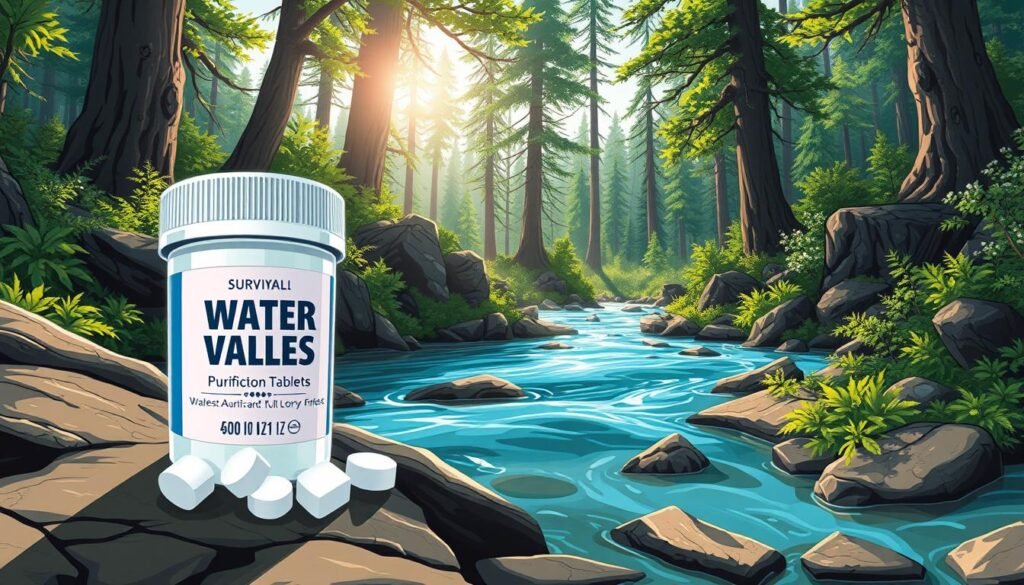
Advanced Techniques: Distillation and Solar Methods
In survival situations, knowing advanced water purification techniques can save your life. Methods like water distillation in the wild and solar water disinfection methods are both effective and good for the environment. They help you get clean drinking water.
Water distillation is great for areas with salty water, common in tropical places. It heats water to make vapor, which then turns back into liquid in a clean container. This method removes minerals and microbes from the water.
Solar water disinfection, or SODIS, uses the sun’s power. It involves putting water in plastic bottles and leaving them in the sun for hours. UV rays kill harmful germs, making it a simple way to purify water with basic resources.
Here’s a look at some main solar desalination and distillation methods:
| Method | Primary Use | Effectiveness | Resource Requirement |
|---|---|---|---|
| Traditional Distillation | Removal of salts and minerals | High | Heat source, distillation apparatus |
| Solar Desalination | Desalinating seawater | Medium to High | Solar panels or direct sunlight |
| Solar Water Disinfection (SODIS) | Pathogen elimination | Medium | Clear plastic bottles, sunlight |
These advanced water purification techniques are strong solutions when usual methods don’t work. Choose the right method based on your environment and available materials.
Water distillation in the wild needs more setup but gives very clean water. On the other hand, solar water disinfection methods are easy to use and need just sunlight. They’re perfect for travelers and adventurers.
Learning and using these techniques can greatly improve your survival and health in tough places where clean water is hard to find.
The Role of Plants in Natural Water Purification
In today’s world, using natural resources is more important than ever. Purifying water with plants and using natural water treatment with vegetation are new ways to clean water. This part talks about how certain plants can clean water, showing their special features and uses.
Identifying Beneficial Plants
Some plants can clean water, like banana peels and Oregon Grape. Oregon Grape’s inner bark has berberine, which fights off bad microbes. Choosing the right plants is key to clean water, as wrong ones can harm health.
How to Use Plants for Potable Water
To make water drinkable with plants, you need to know their biology and how to use them. River oats, for example, are good at filtering out pollutants. Their roots grab pollutants better than other plants, making water cleaner. Using plants for water involves more than just putting them in water. It’s about creating the right space for them to work best.
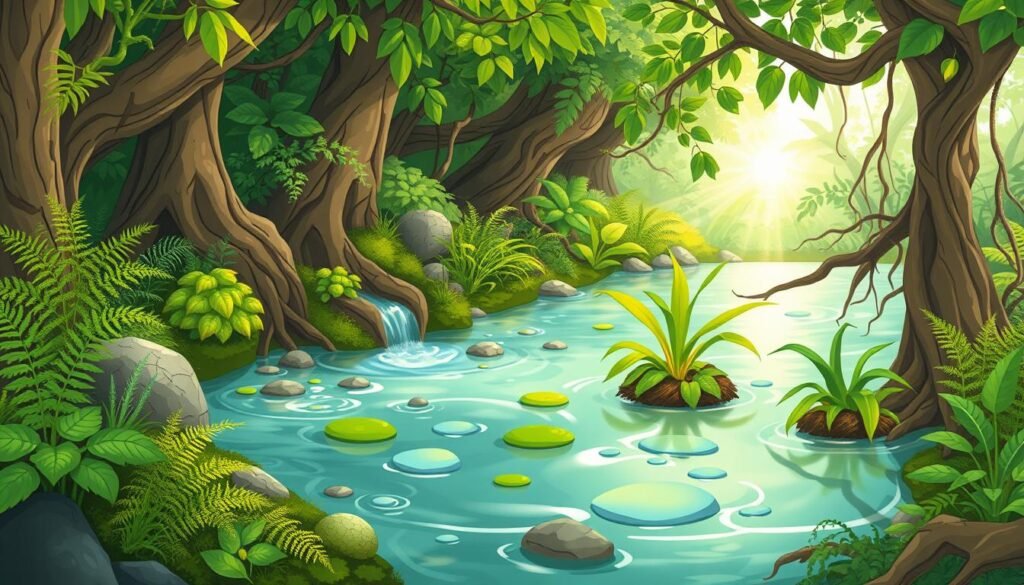
Plants can be used on a big scale too. Communities can use them to make water cleaner. This way, they support health and the environment without spending a lot.
Using plants to clean water is good for the future. It fits with the goal of using green solutions every day. By exploring natural water treatment with vegetation, we not only get clean water but also connect more with nature.
Lifesaving Tips When You Have Limited Resources
When you’re in the wild and resources are low, knowing how to purify water is key. Every drop of water is precious, and making sure it’s safe to drink is vital. We’ll look at simple ways to treat water, like wilderness survival water treatment and improvise water disinfection.
Start with sedimentation. It lets heavy particles settle, making the water clearer. Then, try stone boiling. This ancient method uses hot rocks to kill germs in the water.
You can also make a filter with sand, gravel, and charcoal. Even a cloth can act as a pre-filter to catch big particles. This makes the water cleaner before you use other methods.
If you don’t have purification tablets, a little bleach can work. Just a few drops per gallon can kill germs. But be careful, as bleach can be dangerous.
- Boiling Water: Boil water for at least ten minutes to eliminate most viruses and bacteria.
- Chemical Disinfection: Use iodine or chlorine drops for effective microbial elimination.
- Natural Plant Filtration: Certain plants like Oregon Grape or fruit peels have properties that can purify water naturally.
In emergencies, knowing how to purify water can save your life. Always check your water’s safety with different methods. This helps avoid waterborne diseases.
Also, keep a survival kit with water purification tools. Knowing how to improvise can greatly increase your chances of survival. Having clean water is not just for survival but also for staying healthy in tough times.
Collecting and Purifying Rainwater and Dew in Emergencies
Being stranded in the wilderness means you need to know how to find water. Emergency water collection methods are key. You can collect rainwater and purify dew drops to get clean drinking water.
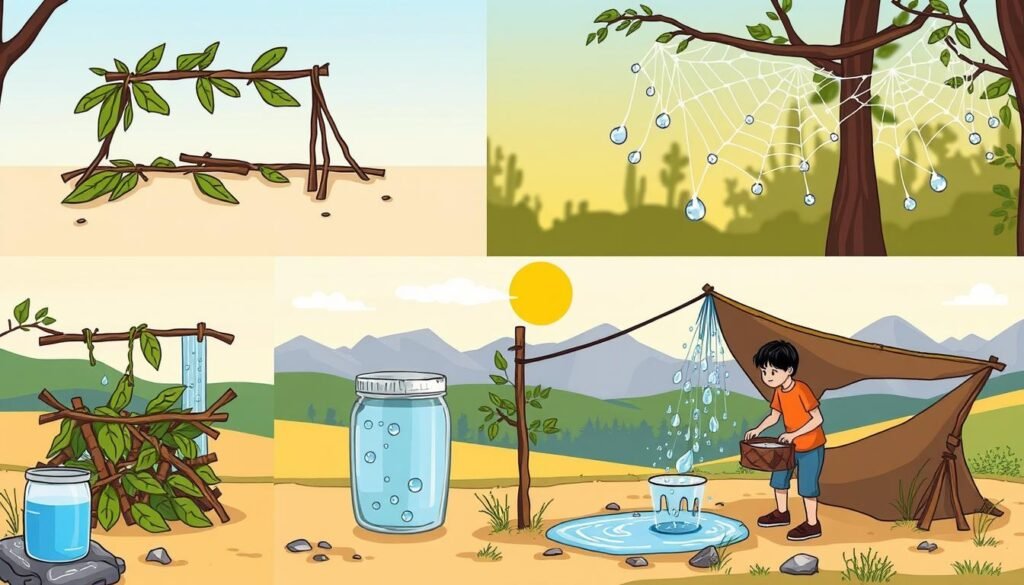
When you can’t find regular water sources, knowing how to collect and purify water is crucial. Rainwater is usually safe to drink if it’s collected cleanly. But, it might pick up contaminants from the air or surfaces, so you need to purify it.
Dew is also a good water source, especially in dry places. You can collect it at dawn using leaves or cloths. After you collect it, you must purify it to remove harmful germs and dirt.
- Boiling water for at least 10 minutes kills all harmful germs.
- Chemical treatments like chlorine or iodine tablets can also disinfect water. For example, Potable Aqua’s iodine tablets kill over 99 percent of germs and make water safe in 35 minutes.
- UV light can purify water quickly by damaging the DNA of germs, making it safe to drink.
Being prepared for emergencies is very important. Having systems to collect and purify rainwater or dew can help you survive. Staying hydrated is also key to keeping your mind and body strong while you’re trying to survive.
Making Use of Portable Purification Gear
When you’re heading out for an adventure or facing a survival situation, having good portable water purification is key. Portable water filters and UV light sterilizers are top choices for their effectiveness and simplicity. They make sure you have safe drinking water and give you peace of mind.
Understanding Different Portable Filter Technologies
Portable water filters have changed how we drink water outdoors. They come in various forms, like straw filters and pump systems. These use technologies like activated carbon and gravity drip systems. Each one has its own strengths and works by removing harmful stuff from water.
Benefits of UV Light Sterilizers
UV light sterilizers purify water without using chemicals. They kill bacteria, viruses, and other harmful stuff with ultraviolet light. This method is effective, easy to carry, and perfect for those without access to clean water.
Knowing about different portable water purification options helps you pick the right one for your needs. Here’s a look at some top products for outdoor and emergency use:
| Product Type | Technology Used | Time to Purify | Capacity |
|---|---|---|---|
| Straw Filters | Charcoal Filtration | Instant | 1,000 liters |
| Pump Filters | Charcoal & Ceramic | 7-10 mins per cup | Variable |
| Gravity Drip Systems | Fabric and Charcoal | 2-3 hours | 10 liters |
| UV Sterilizers | UV Light | 90 seconds | 1 liter |
| Boil Method | Heat | 3+ mins boiling | Variable |
These portable water filters use technology like charcoal to remove contaminants. UV light sterilizers, on the other hand, are quick and effective. They’re great for those who need to purify water fast and without chemicals.
Practical Advice for Preparing Your Survival Water Plan
When you go into the wilderness, having a good survival water plan preparation is key. Knowing how to find and clean water can mean the difference between a great trip and a tough survival situation. It’s important to know how to check for water contaminants and have ways to make water safe.
Assessing and Addressing Contaminants
Water from rivers, lakes, and streams can have harmful germs. These germs can cause diseases like Giardiasis and Cryptosporidiosis. Before drinking, check the water for any signs of contamination. If it’s cloudy, has waste, or smells bad, it might be contaminated.
Using water testing kits can help you know if the water is safe. The best way to make water safe is to boil it. Boiling kills most germs because they can’t handle very hot water. If boiling isn’t possible, chemical treatments like iodine or chlorine drops can also work.
The Significance of Having a Backup Purification Method
It’s not safe to rely on just one way to purify water. What if it doesn’t work or can’t handle certain germs? Always have a backup plan. For example, if a filter pump breaks or clogs, iodine drops can be a lifesaver.
When you can’t use sunlight for purification, having a physical filter or boiling equipment is important. This way, you have a plan B.
- Boiling kills most bacteria and parasites.
- Chemical treatments like iodine or chlorine drops need the right amount and time to work.
- Solar disinfection needs a full sunny day, so a quicker method is needed as a backup.
- Physical filters are handy but should be used with chemical treatments for very dirty water.
Being prepared and knowing about the environment is key for outdoor adventures. Always check the local water and plan ahead. Make sure your survival water plan preparation includes flexible solutions for different situations.
Conclusion
Reflecting on water in the wild, it’s clear that purifying drinking water is crucial. Over 7 million cases of waterborne illnesses are reported yearly in the U.S. Symptoms like diarrhea and vomiting can start within hours of bad water. Knowing how to purify water outdoors is a lifesaving skill for any outdoor lover.
We’ve looked into various ways to purify water in the wild. From boiling to UV sterilization, we’ve seen that using one method isn’t enough. A mix of techniques is needed to remove all harmful particles and germs. For example, a DIY charcoal filter can remove some chemicals and bacteria but not viruses. That’s why using it with boiling or chemical disinfectants is key.
If you’re planning a wilderness trip, here’s a quick guide to the Top 10 water purification products. They include the LifeStraw Personal Water Filter and the Sawyer Products Mini Water Filtration System. There’s also the SteriPEN Ultraviolet Water Purifier and the Katadyn Vario Water Filter. Other options include the MSR Guardian Purifier System and the Aquamira Water Treatment Drops. The Platypus GravityWorks Filter System, Berkey Portable Water Filter Bottle, Survimate Filtered Water Bottle, and PURINIZE Water Purifier Drops are also on the list. Each product has its own features, all aimed at keeping your water clean wherever you go.
